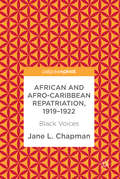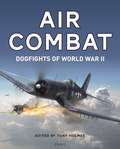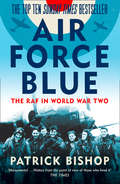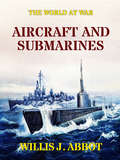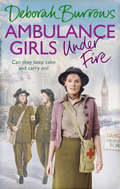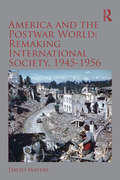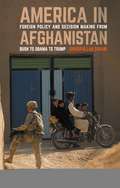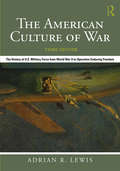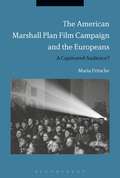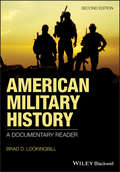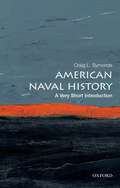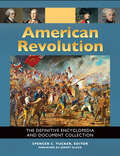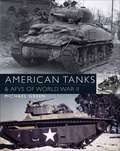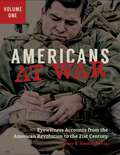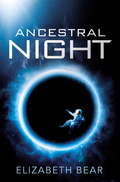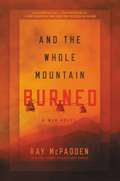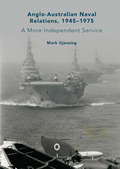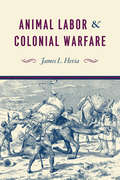- Table View
- List View
African and Afro-Caribbean Repatriation, 1919–1922: Black Voices
by Jane L. ChapmanThis book is the first attempt to analyse records of people of Afro-Caribbean origin who appealed against repatriation during the painful period after Britain’s 1919 race riots. Revealing personal letters and petitions from the West Indies, West Africa, and the UK, Jane Chapman demonstrates that conflict adjustment involving individual voices needs to be highlighted. She asks, what was the human environment, the dilemmas and the racist compulsions making transnational experiences in the British Empire so poignant? Analysing both the opinions of civil servants on appellants’ statements of hardship and requests for financial help, and the voices of the appellants themselves, this book aims to rediscover black people’s hidden heritage.
African and Afro-Caribbean Repatriation, 1919–1922: Black Voices
by Jane L. ChapmanThis book is the first attempt to analyse records of people of Afro-Caribbean origin who appealed against repatriation during the painful period after Britain’s 1919 race riots. Revealing personal letters and petitions from the West Indies, West Africa, and the UK, Jane Chapman demonstrates that conflict adjustment involving individual voices needs to be highlighted. She asks, what was the human environment, the dilemmas and the racist compulsions making transnational experiences in the British Empire so poignant? Analysing both the opinions of civil servants on appellants’ statements of hardship and requests for financial help, and the voices of the appellants themselves, this book aims to rediscover black people’s hidden heritage.
Air Combat: Dogfights of World War II
by Tony Holmes Edward M. Young Aleksander Medved Dmitriy KhazanovThe battle for the skies in World War II fuelled a race between rival air forces to develop ever faster and more capable fighter aircraft – and the struggle for air superiority was never over until the war itself ended. This volume explores four clashes of some of the finest planes and pilots, in key theatres of the war: Spitfires duelling the formidable Bf 109 over the Channel, the Fw 190 battling the Soviet La 5 and 7 on the Eastern Front, the F4F Wildcat in a desperate clash with the legendary A6M Zero-sen, and the F4U Corsair in combat with the second-generation Japanese Ki-84 in the closing days of the war.Fully illustrated with contemporary photographs, maps and colour artwork, Air Combat conveys the full story behind these dramatic aviation duels.
Air Force Blue: The Raf In World War Two - Spearhead Of Victory
by Patrick BishopIn 2018 the RAF is one hundred years old. In his new book, destined to be a classic, Patrick Bishop examines the high point of its existence – the Second World War, when the Air Force saved the nation from defeat then led the advance to victory. A SUNDAY TIMES BESTSELLER
Aircraft and Submarines: The Story Of The Invention, Development, And Present-day Uses Of War's Newest Weapons (classic Reprint) (The World At War)
by Willis J. Abbot(Excerpt) "Not since gunpowder was first employed in warfare has so revolutionary a contribution to the science of slaughtering men been made as by the perfection of aircraft and submarines. The former have had their first employment in this world-wide war of the nations. The latter, though in the experimental stage as far back as the American Revolution, have in this bitter contest been for the first time brought to so practical a stage of development as to exert a really appreciable influence on the outcome of the struggle."
Ambulance Girls Under Fire
by Deborah BurrowsIn times of war, how do you know who to trust?Celia Ashton has driven ambulances throughout the Blitz for the Bloomsbury Auxiliary Ambulance Depot. Cool under fire, she revels in her exciting and extremely dangerous job. When her husband, a known Nazi supporter, is released from prison, Celia refuses to return to her unhappy marriage. Instead she joins forces with Simon Levy, a man who appears to despise her, to help a young Jewish orphan. In so doing she discovers that one ruthless traitor can be more dangerous than any German bomber, and that love can cross any boundary.A heartwarming saga about a woman doing her bit for the war effort. Full of wartime adventure, romance and heartbreak, this is perfect for fans of Daisy Styles, Donna Douglas and Nancy Revell
America and the Postwar World: Remaking International Society, 1945-1956 (Routledge Studies in Modern History)
by David MayersThe main tide of international relations scholarship on the first years after World War II sweeps toward Cold War accounts. These have emphasized the United States and USSR in a context of geopolitical rivalry, with concomitant attention upon the bristling security state. Historians have also extensively analyzed the creation of an economic order (Bretton Woods), mainly designed by Americans and tailored to their interests, but resisted by peoples residing outside of North America, Western Europe, and Japan. This scholarship, centered on the Cold War as vortex and a reconfigured world economy, is rife with contending schools of interpretation and, bolstered by troves of declassified archival documents, will support investigations and writing into the future. By contrast, this book examines a past that ran concurrent with the Cold War and interacted with it, but which usefully can also be read as separable: Washington in the first years after World War II, and in response to that conflagration, sought to redesign international society. That society was then, and remains, an admittedly amorphous thing. Yet it has always had a tangible aspect, drawing self-regarding states into occasional cooperation, mediated by treaties, laws, norms, diplomatic customs, and transnational institutions. The U.S.-led attempt during the first postwar years to salvage international society focused on the United Nations Relief and Rehabilitation Administration, the Acheson–Lilienthal plan to contain the atomic arms race, the Nuremberg and Tokyo tribunals to force Axis leaders to account, the 1948 Genocide Convention, the 1948 Universal Declaration of Human Rights, and the founding of the United Nations. None of these initiatives was transformative, not individually or collectively. Yet they had an ameliorative effect, traces of which have touched the twenty-first century—in struggles to curb the proliferation of nuclear weapons, bring war criminals to justice, create laws supportive of human rights, and maintain an aspirational United Nations, still striving to retain meaningfulness amid world hazards. Together these partially realized innovations and frameworks constitute, if nothing else, a point of moral reference, much needed as the border between war and peace has become blurred and the consequences of a return to unrestraint must be harrowing.
America and the Postwar World: Remaking International Society, 1945-1956 (Routledge Studies in Modern History)
by David MayersThe main tide of international relations scholarship on the first years after World War II sweeps toward Cold War accounts. These have emphasized the United States and USSR in a context of geopolitical rivalry, with concomitant attention upon the bristling security state. Historians have also extensively analyzed the creation of an economic order (Bretton Woods), mainly designed by Americans and tailored to their interests, but resisted by peoples residing outside of North America, Western Europe, and Japan. This scholarship, centered on the Cold War as vortex and a reconfigured world economy, is rife with contending schools of interpretation and, bolstered by troves of declassified archival documents, will support investigations and writing into the future. By contrast, this book examines a past that ran concurrent with the Cold War and interacted with it, but which usefully can also be read as separable: Washington in the first years after World War II, and in response to that conflagration, sought to redesign international society. That society was then, and remains, an admittedly amorphous thing. Yet it has always had a tangible aspect, drawing self-regarding states into occasional cooperation, mediated by treaties, laws, norms, diplomatic customs, and transnational institutions. The U.S.-led attempt during the first postwar years to salvage international society focused on the United Nations Relief and Rehabilitation Administration, the Acheson–Lilienthal plan to contain the atomic arms race, the Nuremberg and Tokyo tribunals to force Axis leaders to account, the 1948 Genocide Convention, the 1948 Universal Declaration of Human Rights, and the founding of the United Nations. None of these initiatives was transformative, not individually or collectively. Yet they had an ameliorative effect, traces of which have touched the twenty-first century—in struggles to curb the proliferation of nuclear weapons, bring war criminals to justice, create laws supportive of human rights, and maintain an aspirational United Nations, still striving to retain meaningfulness amid world hazards. Together these partially realized innovations and frameworks constitute, if nothing else, a point of moral reference, much needed as the border between war and peace has become blurred and the consequences of a return to unrestraint must be harrowing.
America in Afghanistan: Foreign Policy and Decision Making From Bush to Obama to Trump (Library of Modern Middle East Studies)
by Sharifullah DoraniAfghanistan has been a theatre of civil and international conflict for much of the twentieth century – stability is essential if there is to be peace in the Greater Middle East. Yet policy-makers in the West often seem to forget the lessons learned from previous administrations, whose interventions have contributed to the instability in the region. Here, Sharifullah Dorani focuses on the process of decision-making, looking at which factors influenced American policy-makers in the build-up to its longest war, the Afghanistan War, and how reactions on the ground in Afghanistan have influenced events since then. America in Afghanistan is a new, full history of US foreign policy toward Afghanistan from Bush's 'War on Terror', to Obama's war of 'Countering Violent Extremism' to Trump's war against 'Radical Islamic Terrorism'. Dorani is fluent in Pashto and Dari and uses unique and unseen Afghan source-work, published here for the first time, to understand the people in Afghanistan itself, and to answer their unanswered questions about 'real' US Afghan goals, the reasons for US failures in Afghanistan, especially its inability to improve governance and stop Pakistan, Iran and Russia from supporting the insurgency in Afghanistan, and the reasons for the bewildering changes in US Afghan policy over the course of 16 and a half years. To that end the author also assesses Presidents Karzai and Ghani's responses to Bush, Obama and Trump's policies in Afghanistan and the region. In addition, the book covers the role Afghanistan's neighbours – Russia, Iran, India, and especially Pakistan – played in America's Afghanistan War. This will be an essential book for those interested in the future of the region, and those who seek to understand its recent past.
The American Culture of War: The History of U.S. Military Force from World War II to Operation Enduring Freedom
by Adrian R. LewisNow in its third edition, The American Culture of War presents a sweeping critical examination of every major American war since 1941: World War II, Korea, Vietnam, the First and Second Persian Gulf Wars, U.S. operations in Iraq and Afghanistan, and the war against ISIS. As he carefully considers the cultural forces that surrounded each military engagement, Adrian Lewis offers an original and provocative look at the motives, people and governments used to wage war, the discord among military personnel, the flawed political policies that guided military strategy, and the civilian perceptions that characterized each conflict. This third edition features: A new structure focused more exclusively on the character and conduct of the wars themselves Updates to account for the latest, evolving scholarship on these conflicts An updated account of American military involvement in the Middle East, including the abrupt rise of ISIS The new edition of The American Culture of War remains a comprehensive and essential resource for any student of American wartime conduct.
The American Culture of War: The History of U.S. Military Force from World War II to Operation Enduring Freedom
by Adrian R. LewisNow in its third edition, The American Culture of War presents a sweeping critical examination of every major American war since 1941: World War II, Korea, Vietnam, the First and Second Persian Gulf Wars, U.S. operations in Iraq and Afghanistan, and the war against ISIS. As he carefully considers the cultural forces that surrounded each military engagement, Adrian Lewis offers an original and provocative look at the motives, people and governments used to wage war, the discord among military personnel, the flawed political policies that guided military strategy, and the civilian perceptions that characterized each conflict. This third edition features: A new structure focused more exclusively on the character and conduct of the wars themselves Updates to account for the latest, evolving scholarship on these conflicts An updated account of American military involvement in the Middle East, including the abrupt rise of ISIS The new edition of The American Culture of War remains a comprehensive and essential resource for any student of American wartime conduct.
The American Marshall Plan Film Campaign and the Europeans: A Captivated Audience?
by Maria FritscheThe US government launched the European Recovery Programme, otherwise known as the 'Marshall Plan', in order to save war-torn Europe from collapse in 1948. Yet while much is known about the economic side of the Marshall Plan, the extensive film campaign that accompanied it has been largely overlooked until now. The American Marshall Plan Film Campaign and the Europeans is the first book to explore the use of the Marshall Plan films and, importantly, their distribution and reception across Europe. The study examines every available film – the 170 that remain from the 200 estimated to have been made – and looks at how they were designed to instil hope, argue the case for economic restructuring and persuade the Europeans of the superiority of the liberal-capitalist system. The book goes on to reason that the films served as a powerful weapon in the cultural Cold War, but that the European audiences were by no means passive victims of the US propaganda effort. Maria Fritsche discusses the Marshall Plan films in the context of countries across Western, Northern and Southern Europe, covering the majority of the 17 European countries that participated in the Plan in the process. The book incorporates 70 images and utilises a vast number of archival sources to explore the strategies the US adopted to sway the minds of the Europeans, the problems they encountered in the process and, not least, the varied responses of the European audiences. It is a vital study for any scholar or student keen to know more about postwar recovery in Europe, the legacy of the Second World War or America's relationship with Europe in the 20th century.
The American Marshall Plan Film Campaign and the Europeans: A Captivated Audience?
by Maria FritscheThe US government launched the European Recovery Programme, otherwise known as the 'Marshall Plan', in order to save war-torn Europe from collapse in 1948. Yet while much is known about the economic side of the Marshall Plan, the extensive film campaign that accompanied it has been largely overlooked until now. The American Marshall Plan Film Campaign and the Europeans is the first book to explore the use of the Marshall Plan films and, importantly, their distribution and reception across Europe. The study examines every available film – the 170 that remain from the 200 estimated to have been made – and looks at how they were designed to instil hope, argue the case for economic restructuring and persuade the Europeans of the superiority of the liberal-capitalist system. The book goes on to reason that the films served as a powerful weapon in the cultural Cold War, but that the European audiences were by no means passive victims of the US propaganda effort. Maria Fritsche discusses the Marshall Plan films in the context of countries across Western, Northern and Southern Europe, covering the majority of the 17 European countries that participated in the Plan in the process. The book incorporates 70 images and utilises a vast number of archival sources to explore the strategies the US adopted to sway the minds of the Europeans, the problems they encountered in the process and, not least, the varied responses of the European audiences. It is a vital study for any scholar or student keen to know more about postwar recovery in Europe, the legacy of the Second World War or America's relationship with Europe in the 20th century.
American Military History: A Documentary Reader
by Brad D. LookingbillA collection of primary documents that explore the many facets of the American military from the colonial period to the present The second edition of American Military History offers an exceptional collection of primary documents relating to history of the military of the United States from 1607 through the present. The writings offer insight into the armed forces in relation to the social, cultural, economic, political, and territorial development of the United States. Several documents comment on strategic initiatives, combat operations, force structure, public policy, and home fronts. The writings also present firsthand testimony of extraordinary men and women in uniform and most of the documents explore the connections between combatants and the societies that produced them. From the beginnings of the war against the natives through the tragedy of the Civil War and up to the current Global War on Terror, American Military History offers a chronological account of the evolution of the United States military. This vital text: Includes writings that explore the diversity of the armed forces Explores leadership in America’s military affairs Traces America’s ways of war beginning in 1607 through the present Examines the patterns of design and purpose of the American military over time Reveals the vitality of civil-military relations in the United States Written for academics and students of military history, American Military History is an important text that draws on primary sources to explore the many facets of America’s military history.
American Naval History: Five Naval Battles That Shaped American History (Very Short Introductions)
by Craig L. SymondsThis fast-paced narrative charts the history of the US Navy from its birth during the American Revolution through to its current superpower status. The story highlights iconic moments of great drama pivotal to the nation's fortunes: John Paul Jones' attacks on the British during the Revolution, the Barbary Wars, and the arduous conquest of Iwo Jima. American Naval History: A Very Short Introduction illuminates the changes--technological, institutional, and functional--of the U.S. Navy from its days as a small frigate navy through the age of steam and steel to the modern era of electronics and missiles. Renowned naval historian Craig L. Symonds captures the evolving culture of the navy and debates between policymakers about what role the institution should play in world affairs. Internal and external challenges dramatically altered the size and character of the navy, with long periods of quiet inertia alternating with periods of crisis that spurred rapid expansion. The history of the navy reflects the history of the nation as a whole, and its many changes derive in large part from the changing role of the United States itself. ABOUT THE SERIES: The Very Short Introductions series from Oxford University Press contains hundreds of titles in almost every subject area. These pocket-sized books are the perfect way to get ahead in a new subject quickly. Our expert authors combine facts, analysis, perspective, new ideas, and enthusiasm to make interesting and challenging topics highly readable.
American Revolution [5 volumes]: The Definitive Encyclopedia and Document Collection [5 volumes]
by Dr Spencer C. TuckerWith more than 1,300 cross-referenced entries covering every aspect of the American Revolution, this definitive scholarly reference covers the causes, course, and consequences of the war and the political, social, and military origins of the nation.This authoritative and complete encyclopedia covers not only the eight years of the American Revolutionary War (1775–1783) but also the decades leading up to the war, beginning with the French and Indian War, and the aftermath of the conflict, with an emphasis on the early American Republic. Volumes one through four contain a series of overview essays on the causes, course, and consequences of the American Revolution, followed by impeccably researched A–Z entries that address the full spectrum of political, social, and military matters that arose from the conflict. Each entry is cross-referenced to other entries and also lists books for further reading. In addition, there is a detailed bibliography, timeline, and glossary.A fifth volume is devoted to primary sources, each of which is accompanied by an insightful introduction that places the document in its proper historical context. The primary sources help readers to understand the myriad motivations behind the American Revolution; the diplomatic, military, and political maneuvering that took place during the conflict; and landmark documents that shaped the founding and early development of the United States.
American Tanks & AFVs of World War II (General Military Ser.)
by Michael GreenThe entry of the US into World War II provided the Allies with the industrial might to finally take the war to German and Japanese forces across the world. Central to this was the focus of the American military industrial complex on the manufacture of tanks and armoured fighting vehicles. Between 1939 and 1945, 88,140 tanks and 18,620 other armored vehicles were built – almost twice the number that Germany and Great Britain combined were able to supply. In this lavishly illustrated volume, armour expert Michael Green examines the dizzying array of machinery fielded by the US Army, from the famed M4 Sherman, M3 Stuart and M3 Lee through to the half-tracks, armored cars, self-propelled artillery, tank destroyers, armored recovery vehicles and tracked landing vehicles that provided the armoured fist that the Allies needed to break Axis resistance in Europe and the Pacific. Publishing in paperback for the first time and packed with historical and contemporary colour photography, this encyclopedic new study details the design, development, and construction of these vehicles, their deployment in battle and the impact that they had on the outcome of the war.
Americans at War [3 volumes]: Eyewitness Accounts from the American Revolution to the 21st Century [3 volumes]
by James R. ArnoldThis unprecedented compilation of eyewitness accounts records the thoughts and emotions of American soldiers spanning nearly 250 years of national history, from the American Revolution to the Afghanistan War.Understanding primary sources is essential to understanding warfare. This outstanding collection provides a diverse set of eyewitness accounts of Americans in combat throughout U.S. history. Offering riveting true stories, it includes accounts from participants in the American Revolution, the War of 1812, the Indian Wars, the Mexican-American War, the Civil War, the Spanish American War and Philippine Insurrection, World War I, World War II, the Korean War, the Vietnam War, The Persian Gulf War, the Afghanistan War, and the Iraq War.Most eyewitness accounts of war currently available to the public are those of writers who enjoy higher military rank. Americans at War addresses this imbalance between officers' accounts and enlisted men's accounts by invoking oral history archives. Contextual essays and timelines allow the reader to place the accounts in time and place, while the entries themselves allow the reader to experience the thoughts and emotions of Americans who engaged in combat.
Ancestral Night: A White Space Novel (White Space Ser. #1)
by Elizabeth BearA space salvager and her partner make the discovery of a lifetime that just might change the universe in this wild, big-ideas space opera from multi award-winning author Elizabeth Bear.Haimey Dz thinks she knows what she wants.She thinks she knows who she is.She is wrong.A routine salvage mission uncovers evidence of a terrible crime and relics of a powerful ancient technology, just as Haimey and her small crew run afoul of pirates at the outer limits of the Milky Way and find themselves both on the run, and in possession of ancient, universe-changing technology.When the authorities prove corrupt, it becomes clear that Haimey is the only one who can protect her galaxy-spanning civilisation from its potential power - and from the revolutionaries who want to use it to seed terror and war. But doing so will take her from the event horizon of the super-massive black hole at the galaxy's core to the infinite, empty spaces at its edge. Along the way, she'll have to uncover the secrets of ancient intelligences lost to time as well as her own lost secrets, which she will wish had remained hidden from her forever . . .Energetic and electrifying, Ancestral Night is a dazzling new space opera, sure to delight fans of Alastair Reynolds, Iain M. Banks, and Peter F. Hamilton.Praise for Elizabeth Bear'Gripping, perfectly balanced, and highly recommended' Kirkus'Like the best of speculative fiction, Bear has created a fascinating and complete universethat blends high-tech gadgetry with Old World adventure and political collusion' Publishers Weekly
Anglo-Australian Naval Relations, 1945–1975: A More Independent Service
by Mark GjessingThis book examines Anglo-Australian naval relations between 1945-75, a period of great change for both Australia and Great Britain and their respective navies. It explores the cultural and historical ties between the Royal Navy and the Royal Australian Navy (RAN), the efficacy of communications between the services, and the importance of personal relations to the overall inter-service relationship. The author assesses the dilemmas faced by Great Britain associated with that nation’s declining power, and the impact of the retreat from ‘East of Suez’ on the strategic relationship between the United Kingdom and Australia. The book also considers operational co-operation between the Royal Navy and the RAN including conflicts such as the Korean War, the Malayan Emergency, and confrontation with Indonesia, as well as peacetime pursuits such as port visits and the testing of atomic weapons in the 1950s. Co-operation in matters of personnel and training are also dealt with in great detail, along with the co-operation between the Royal Navy and the RAN in equipment procurement and design and the increased ability of the RAN to look to non-British sources for equipment procurement. The book considers the impact of stronger Australian-American ties on the RAN and appraises the role it played in the conflict in Vietnam.
Anglo-Australian Naval Relations, 1945–1975 (PDF)
by Mark GjessingThis book examines Anglo-Australian naval relations between 1945-75, a period of great change for both Australia and Great Britain and their respective navies. It explores the cultural and historical ties between the Royal Navy and the Royal Australian Navy (RAN), the efficacy of communications between the services, and the importance of personal relations to the overall inter-service relationship. The author assesses the dilemmas faced by Great Britain associated with that nation’s declining power, and the impact of the retreat from ‘East of Suez’ on the strategic relationship between the United Kingdom and Australia. The book also considers operational co-operation between the Royal Navy and the RAN including conflicts such as the Korean War, the Malayan Emergency, and confrontation with Indonesia, as well as peacetime pursuits such as port visits and the testing of atomic weapons in the 1950s. Co-operation in matters of personnel and training are also dealt with in great detail, along with the co-operation between the Royal Navy and the RAN in equipment procurement and design and the increased ability of the RAN to look to non-British sources for equipment procurement. The book considers the impact of stronger Australian-American ties on the RAN and appraises the role it played in the conflict in Vietnam.
Animal Labor and Colonial Warfare
by James L. HeviaUntil well into the twentieth century, pack animals were the primary mode of transport for supplying armies in the field. The British Indian Army was no exception. In the late nineteenth century, for example, it forcibly pressed into service thousands of camels of the Indus River basin to move supplies into and out of contested areas—a system that wreaked havoc on the delicately balanced multispecies environment of humans, animals, plants, and microbes living in this region of Northwest India. In Animal Labor and Colonial Warfare, James Hevia examines the use of camels, mules, and donkeys in colonial campaigns of conquest and pacification, starting with the Second Afghan War—during which an astonishing 50,000 to 60,000 camels perished—and ending in the early twentieth century. Hevia explains how during the nineteenth and twentieth centuries a new set of human-animal relations were created as European powers and the United States expanded their colonial possessions and attempted to put both local economies and ecologies in the service of resource extraction. The results were devastating to animals and human communities alike, disrupting centuries-old ecological and economic relationships. And those effects were lasting: Hevia shows how a number of the key issues faced by the postcolonial nation-state of Pakistan—such as shortages of clean water for agriculture, humans, and animals, and limited resources for dealing with infectious diseases—can be directly traced to decisions made in the colonial past. An innovative study of an underexplored historical moment, Animal Labor and Colonial Warfare opens up the animal studies to non-Western contexts and provides an empirically rich contribution to the emerging field of multispecies historical ecology.
Animal Labor and Colonial Warfare
by James L. HeviaUntil well into the twentieth century, pack animals were the primary mode of transport for supplying armies in the field. The British Indian Army was no exception. In the late nineteenth century, for example, it forcibly pressed into service thousands of camels of the Indus River basin to move supplies into and out of contested areas—a system that wreaked havoc on the delicately balanced multispecies environment of humans, animals, plants, and microbes living in this region of Northwest India. In Animal Labor and Colonial Warfare, James Hevia examines the use of camels, mules, and donkeys in colonial campaigns of conquest and pacification, starting with the Second Afghan War—during which an astonishing 50,000 to 60,000 camels perished—and ending in the early twentieth century. Hevia explains how during the nineteenth and twentieth centuries a new set of human-animal relations were created as European powers and the United States expanded their colonial possessions and attempted to put both local economies and ecologies in the service of resource extraction. The results were devastating to animals and human communities alike, disrupting centuries-old ecological and economic relationships. And those effects were lasting: Hevia shows how a number of the key issues faced by the postcolonial nation-state of Pakistan—such as shortages of clean water for agriculture, humans, and animals, and limited resources for dealing with infectious diseases—can be directly traced to decisions made in the colonial past. An innovative study of an underexplored historical moment, Animal Labor and Colonial Warfare opens up the animal studies to non-Western contexts and provides an empirically rich contribution to the emerging field of multispecies historical ecology.
Animal Labor and Colonial Warfare
by James L. HeviaUntil well into the twentieth century, pack animals were the primary mode of transport for supplying armies in the field. The British Indian Army was no exception. In the late nineteenth century, for example, it forcibly pressed into service thousands of camels of the Indus River basin to move supplies into and out of contested areas—a system that wreaked havoc on the delicately balanced multispecies environment of humans, animals, plants, and microbes living in this region of Northwest India. In Animal Labor and Colonial Warfare, James Hevia examines the use of camels, mules, and donkeys in colonial campaigns of conquest and pacification, starting with the Second Afghan War—during which an astonishing 50,000 to 60,000 camels perished—and ending in the early twentieth century. Hevia explains how during the nineteenth and twentieth centuries a new set of human-animal relations were created as European powers and the United States expanded their colonial possessions and attempted to put both local economies and ecologies in the service of resource extraction. The results were devastating to animals and human communities alike, disrupting centuries-old ecological and economic relationships. And those effects were lasting: Hevia shows how a number of the key issues faced by the postcolonial nation-state of Pakistan—such as shortages of clean water for agriculture, humans, and animals, and limited resources for dealing with infectious diseases—can be directly traced to decisions made in the colonial past. An innovative study of an underexplored historical moment, Animal Labor and Colonial Warfare opens up the animal studies to non-Western contexts and provides an empirically rich contribution to the emerging field of multispecies historical ecology.
